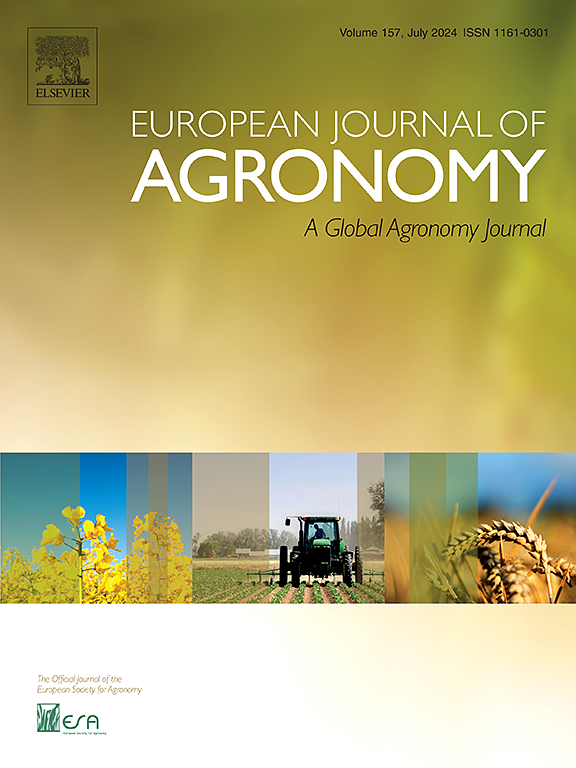结合适度的灌溉水温和施氮量,提高氮素利用率和籽棉产量
IF 4.5
1区 农林科学
Q1 AGRONOMY
引用次数: 0
摘要
为促进地下水的高效利用,提高氮肥肥效,研究了合理的氮肥施用量和灌溉水温范围。2022 年和 2023 年,在中国新疆进行了一项田间试验,涉及四种灌溉水温水平(T0:15 °C、T1:20 °C、T2:25 °C、T3:30 °C)和三种施氮量(F1:250 kg ha-1、F2:300 kg ha-1、F3:350 kg ha-1)。结果表明,土壤含氮量、棉花干物质重量、棉花含氮量、籽棉产量和氮部分要素生产率(NPFP)随着施氮量的增加而提高。然而,随着灌溉水温的升高,土壤含氮量下降,而棉花干物质重量、棉花含氮量、籽棉产量和氮部分要素生产率则先上升后下降。值得注意的是,在所有处理中,T2F2(25 °C,300 千克/公顷)和 T2F1(25 °C,250 千克/公顷)产量最高,分别为 6652 千克/公顷和 6941 千克/公顷;在 2022 年和 2023 年,T2F2(25 °C,300 千克/公顷)和 T2F1(25 °C,250 千克/公顷)产量最高,分别为 24.20 千克/公顷和 25.20 千克/公顷。此外,利用多元回归和空间分析方法,确定了灌溉水温的最佳范围为 23.82-27.41 °C,施氮量为 276.43-289.23 kg ha-1,以实现 80% 以上的最高籽棉产量和 NPFP。这项研究为优化灌溉和施肥策略,提高资源利用效率,促进干旱地区棉花可持续生产提供了宝贵的指导。本文章由计算机程序翻译,如有差异,请以英文原文为准。
Combination with moderate irrigation water temperature and nitrogen application rate enhances nitrogen utilization and seed cotton yield
To promote the efficient utilization of groundwater and improve nitrogen fertilizer effectiveness, a reasonable range of nitrogen application rates and irrigation water temperature was investigated. A field experiment was conducted in Xinjiang, China, in 2022 and 2023, involving four irrigation water temperature levels (T0: 15 °C, T1: 20 °C, T2: 25 °C, and T3: 30 °C) and three nitrogen application rates (F1: 250 kg ha−1, F2: 300 kg ha−1, and F3: 350 kg ha−1). The results indicated that soil nitrogen content, cotton dry matter weight, cotton nitrogen content, seed cotton yield, and nitrogen partial factor productivity (NPFP) increased with higher nitrogen application rates. However, as irrigation water temperature increased, soil nitrogen content decreased, whereas cotton dry matter weight, cotton nitrogen content, seed cotton yield, and NPFP initially increased before declining. Notably, the maximum yield and NPFP among all treatments were observed in T2F2 (25 °C, 300 kg ha−1), yielding 6652 kg ha–1 and 6941 kg ha–1, and in T2F1 (25 °C, 250 kg ha–1), with 24.20 kg kg–1 and 25.20 kg kg–1 in 2022 and 2023, respectively. Furthermore, the optimal range of irrigation water temperature of 23.82–27.41 °C and nitrogen application rate of 276.43–289.23 kg ha–1 were identified to achieve over 80 % of the highest seed cotton yield and NPFP using multiple regression and spatial analysis methods. This study offers valuable guidance for optimizing irrigation and fertilization strategies to enhance resource efficiency and promote sustainable cotton production in arid regions.
求助全文
通过发布文献求助,成功后即可免费获取论文全文。
去求助
来源期刊

European Journal of Agronomy
农林科学-农艺学
CiteScore
8.30
自引率
7.70%
发文量
187
审稿时长
4.5 months
期刊介绍:
The European Journal of Agronomy, the official journal of the European Society for Agronomy, publishes original research papers reporting experimental and theoretical contributions to field-based agronomy and crop science. The journal will consider research at the field level for agricultural, horticultural and tree crops, that uses comprehensive and explanatory approaches. The EJA covers the following topics:
crop physiology
crop production and management including irrigation, fertilization and soil management
agroclimatology and modelling
plant-soil relationships
crop quality and post-harvest physiology
farming and cropping systems
agroecosystems and the environment
crop-weed interactions and management
organic farming
horticultural crops
papers from the European Society for Agronomy bi-annual meetings
In determining the suitability of submitted articles for publication, particular scrutiny is placed on the degree of novelty and significance of the research and the extent to which it adds to existing knowledge in agronomy.
 求助内容:
求助内容: 应助结果提醒方式:
应助结果提醒方式:


